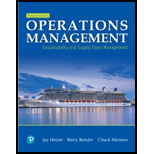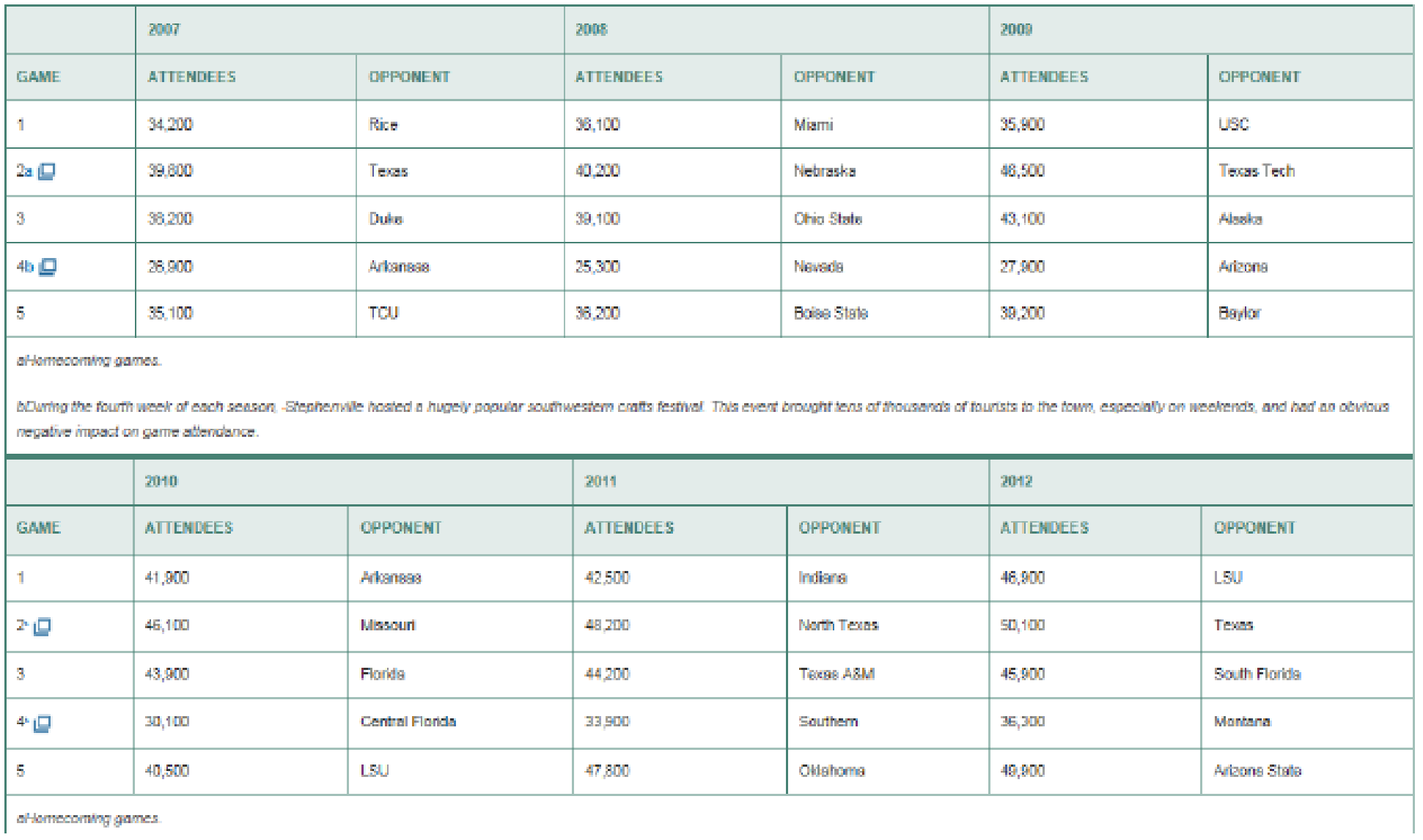
Concept explainers
Case study
Southwestern University: (B)*
*This integrated case study runs throughout the text. Other issues facing Southwestern’s football stadium include (A) managing the stadium project (Chapter 3); (C) quality of facilities (Chapter 6); (D) break-even analysis of food services (Supplement 7 web site): (E) locating the new stadium (Chapter 8 web site); (F) inventory planning of football programs (Chapter 12 web site); and (G)
Southwestern University (SWU), a large state college in Stephenville, Texas, enrolls close to 20,000 students. The school is a dominant force in the small city, with more students during fall and spring than permanent residents.
Always a football powerhouse, SWU is usually in the top 20 in college football rankings. Since the legendary Phil Flamm was hired as its head coach in 2006 (in hopes of reaching the elusive number 1 ranking), attendance at the five Saturday home games each year increased. Prior to Flamm’s arrival, attendance generally averaged 25,000 to 29,000 per game. Season ticket sales bumped up by 10,000 just with the announcement of the new coach’s arrival. Stephenville and SWU were ready to move to the big time!
The immediate issue facing SWU, however, was not NCAA ranking. It was capacity. The existing SWU stadium, built in 1953, has seating for 54,000 fans. The following table indicates attendance at each game for the past 6 years.
One of Flamm’s demands upon joining SWU had been a stadium expansion, or possibly even a new stadium. With attendance increasing, SWU administrators began to face the issue head-on. Flamm had wanted dormitories solely for his athletes in the stadium as an additional feature of any expansion.
SWU’s president, Dr. Joel Wisner, decided it was time for his vice president of development to forecast when the existing stadium would “max out.” The expansion was, in his mind, a given. But Wisner needed to know how long he could wait. He also sought a revenue projection, assuming an average ticket price of $50 in 2013 and a 5% increase each year in future prices.
Southwestern University Football Game Attendance, 2007–2012

- 1. Develop a
forecasting model, justifying its selection over other techniques, and project attendance through 2014.
Want to see the full answer?
Check out a sample textbook solution
Chapter 4 Solutions
Mylab Operations Management With Pearson Etext -- Access Card -- For Operations Management: Sustainability And Supply Chain Management (13th Edition)
Additional Business Textbook Solutions
Financial Accounting, Student Value Edition (5th Edition)
Intermediate Accounting (2nd Edition)
Horngren's Accounting (12th Edition)
Gitman: Principl Manageri Finance_15 (15th Edition) (What's New in Finance)
Marketing: An Introduction (13th Edition)
Operations Management: Processes and Supply Chains (12th Edition) (What's New in Operations Management)
- i). Complete the table assuming a Level production plan. ii) Comment on your results and explain whether at this stage, you consider a Level plan is a suitable approach for this particular business. Your comment should include reference to a calculated ‘fill rate’.arrow_forwardIn the following sawtooth inventory profile diagram, two inventory plans with different order quantities (Q) and different frequencies of delivery are shown; order quantity for Plan A = 200 units and Plan B = 50 units. i). Total demand (D) is 350 units, the holding cost per unit (Ch) is equal to (£0.8) and the ordering cost per order (Co) is (£12.5). Calculate the total costs for each plan and state which one is more preferable along with the reason why. ii). There is a stark difference in the composition of the total costs of Plans A and B. Explain this difference and why it occurs. Use the breakdown of costs for each plan to help illustrate your answer.arrow_forwardi). Complete the table for a Chase production plan. ii). Explain whether a Level or Chase plan is more suitable for the demand pattern experienced by this particular business, which incidentally relies on highly skilled workers in the production process. Assume a starting workforce of 7 and that fractional workers are permissible. You should support your answer with numerical data derived from Table 3. In comparing the costs, state any other assumptions made.arrow_forward
- i). Complete for a Chase production plan. ii). Explain whether a Level or Chase plan is more suitable for the demand pattern experienced by this particular business, which incidentally relies on highly skilled workers in the production process. Assume a starting workforce of 7 and that fractional workers are permissible.arrow_forwardComplete the table for a Chase production plan.arrow_forwardHow much can the garden centre expect to sell during each quarter of next year (Year 3) accounting for seasonality? Your forecast must make use of seasonal indices. All workings must be shown in full. (NOTE: Please round your calculations to three decimal places).arrow_forward
- PS.53 Brother I.D. Ricks is a faculty member at BYU-Idaho whose grandchildren live in Oklahoma and California. He and his wife would like to visit their grandchildren at least once a year in these states. They currently have one vehicle with well over 100,000 miles on it, so they want to buy a newer vehicle with fewer miles and that gets better gas mileage. They are considering two options: (1) a new subcompact car that would cost $18,750 to purchase or (2) a used sedan that would cost $12,750.They anticipate that the new subcompact would get 37 miles per gallon (combined highway and around town driving) while the sedan would get 26 miles per gallon. Based on their road tripping history they expect to drive 13,000 miles per year. For the purposes of their analysis they are assuming that gas will cost $2.93 per gallon.Question: How many miles would the Ricks need to drive before the cost of these two options would be the same? (Display your answer to the nearest whole number.) (Hint:…arrow_forwardTisjTzktxyduduarrow_forwardNot use ai pleasearrow_forward
- Not use ai pleasearrow_forwardWhat is Bitcoin? How important is it to businesses and individuals? How does it cause environmental damage and is that damage worth continued uses of Bitcoin? Read the following articles to help answer these questions: United Nations University. (2023, October 24). UN study reveals the hidden environmental impacts of bitcoin: Carbon is not the only harmful by-product. https://unu.edu/press-release/un-study-reveals-hidden-environmental-impacts-bitcoin-carbon-not-only-harmful-product#:~:text=Bitcoin%2C%20the%20most%20popular%20cryptocurrency,the%20worldwide%20Bitcoin%20mining%20network. Salam, E. (2023, April 26). Bitcoin is terrible for the environment – can it ever go green? The Guardian. https://www.theguardian.com/technology/2023/apr/26/bitcoin-mining-climate-crisis-environmental-impactarrow_forward419 X .com/courses/1546/assignments/49499?module_item_id=111573 Unlimited Attempts Allowed ✓ Details Directions: Record a video of yourself giving a business presentation. Imagine you are tasked with researching a professional development topic on business communication for 40 coworkers. You are then expected to give a 4 - 5 minute presentation on the topic. Choose any topic related to business communication, such as intercultural communication, effective leadership, professional writing, etc. Research the topic and prepare a 4 - 5 minute presentation that could be given over video conference call (such as Zoom). You may use visual aids if you choose. Upload a video file of your presentation. Provide all needed citations. Requirements: 4-5 minutes long Contains visual and audio Create your own work; do not plagiarize Cite your sources using APA citations Choose a submission type Tarrow_forward
 Purchasing and Supply Chain ManagementOperations ManagementISBN:9781285869681Author:Robert M. Monczka, Robert B. Handfield, Larry C. Giunipero, James L. PattersonPublisher:Cengage LearningMarketingMarketingISBN:9780357033791Author:Pride, William MPublisher:South Western Educational Publishing
Purchasing and Supply Chain ManagementOperations ManagementISBN:9781285869681Author:Robert M. Monczka, Robert B. Handfield, Larry C. Giunipero, James L. PattersonPublisher:Cengage LearningMarketingMarketingISBN:9780357033791Author:Pride, William MPublisher:South Western Educational Publishing Practical Management ScienceOperations ManagementISBN:9781337406659Author:WINSTON, Wayne L.Publisher:Cengage,
Practical Management ScienceOperations ManagementISBN:9781337406659Author:WINSTON, Wayne L.Publisher:Cengage,




